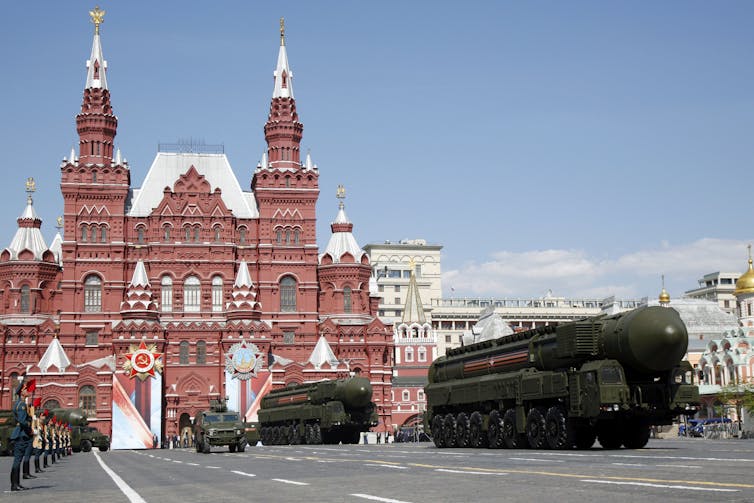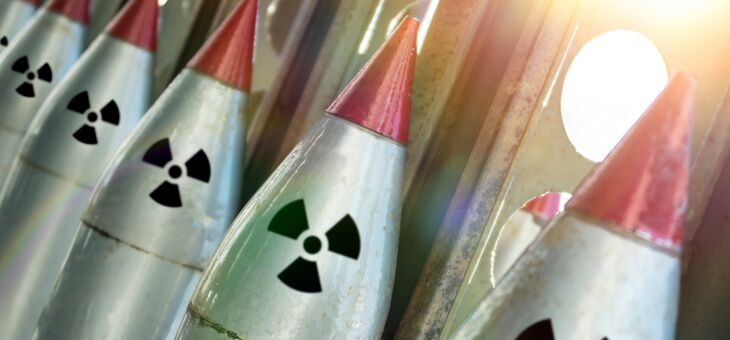Tanya Ogilvie-White, Australian National University
Russian president Vladimir Putin overnight ordered the defence minister and the chief of the military to put nuclear deterrent forces in a “special regime of combat duty”, possibly referring to readying tactical nuclear forces.
This could of course be a bluff, but Putin has demonstrated on numerous occasions that he has a cavalier disrespect for human life and for the planet, and is willing to take extreme risks to achieve his strategic goals.
The risk Putin would order the use of nuclear weapons in response to a US or NATO intervention is low, but it cannot be dismissed. The US has described the escalation as “dangerous rhetoric”.
This deeply worrying development underscores how high the global nuclear stakes have become in recent weeks. The war in Ukraine should be a wake-up call to everyone that nuclear dangers are real.
Will we act to eliminate the nuclear threat or press mute on the alarm and drift back to sleep?
Five genuine nuclear dangers
Nuclear weapons aren’t just abstract instruments intended to deter aggression and maintain stability.
As countries modernise and expand their nuclear weapons arsenals, experts around the world have been warning nuclear weapons are increasingly being seen as ‘usable’ by the political and military leaders who wield them.
They could be used:
-
in a strategy to gain the upper hand
-
in an escalating conflict to try to force an adversary to back down
-
as a weapon of last resort
-
in response to an incoming missile that is mistakenly believed to be nuclear-armed
-
by accident if command and control systems break down.
The fact Ukraine does not possess nuclear weapons doesn’t negate these risks. There are genuine dangers the conflict could take on a nuclear dimension.
Possible nuclear scenarios
Nuclear capabilities abound in Europe, and nuclear intentions can be hard to decipher.
On one side, Ukraine’s attacker, Russia, has the largest stockpile of nuclear warheads in the world, including superiority in tactical nuclear weapons designed for battlefield use.
On the other side, Ukraine’s most powerful strategic partner, the United States, also has an extremely large and sophisticated nuclear stockpile. NATO partners France and the UK have their own advanced nuclear capabilities; and NATO-sharing states Belgium, Germany, Italy, the Netherlands, and Turkey host US nuclear weapons on their territory.

AP Photo/Alexander Zemlianichenko
The risk of nuclear use stems from tensions escalating between Russia, the US and NATO, even as the latter try to resist being drawn directly into the war.
Although it is extremely unlikely the US or its NATO allies would set out to conduct a nuclear strike against Russia, it is possible to imagine several scenarios that could lead them to become entangled in the conflict, leading to unintended nuclear escalation.
The most serious danger is that of misperception: the risk that action taken by the US or NATO in support of Ukraine is misinterpreted by Russia as a deliberate strategic provocation.
This is not a far-fetched scenario given Russia’s nuclear posture, which maintains nuclear forces on high alert, and given the nuclear threats made by President Putin.
In the minutes before the military offensive began, Putin threatened anyone who intervenes with
Consequences as you have never before experienced in your history.
It was a chilling reminder that Russia (like France, Pakistan, the UK, the US and possibly North Korea), does not rule out using nuclear weapons first in a conflict.
Would Putin follow through with his threat? At the time, he made sure to emphasise that Russia “has certain advantages in a number of the latest types of nuclear weapons” in case anyone was in any doubt.
What’s needed now
This raises urgent questions about how to support Ukraine and de-escalate the conflict. The war needs to be stopped, for the sake of the Ukrainian people, for the sake of Europe, for the sake of humanity, and for the sake of life on earth.
This might sound like hyperbole until you consider that if the international community fails to mount an effective response to Putin’s actions in Ukraine, it will signal the beginning of a brutal new era of ‘rule by might’.
A world in which the leaders of nuclear-armed states can pursue expansionist campaigns unconstrained by international law, and without fear of reprisal.
Two steps are vital.
First, political leaders must come together in support of collective security and international law. Economic sanctions are not enough. UN member states should use the UN system in the way it was originally designed to function in the post-war era, to respond collectively and decisively to acts of aggression.
With UN Security Council action blocked by the Russian veto, the UN General Assembly has the power to act via the ‘Uniting for Peace’ principle, which imposes a duty on UN member states to implement a coordinated response to aggression when the Security Council fails to respond.
Second, ordinary people around the world need to make it clear we will no longer tolerate living under the threat of nuclear war.
Nuclear weapons empower erratic and volatile heads of governments in despotic and democratic countries alike and create unacceptable risks for all humanity.
They are not stabilisers. They do not create ‘order’. Nuclear deterrence has failed again and again, bringing the world to the brink on too many occasions.
It’s time to demand the elimination of nuclear weapons and the creation of stable security arrangements based on a properly functioning UN system that upholds international law.
Tanya Ogilvie-White, Senior Fellow at the Coral Bell School of Asia Pacific Affairs, Australian National University
This article is republished from The Conversation under a Creative Commons licence. Read the original article.
If you enjoy our content, don’t keep it to yourself. Share our free eNews with your friends and encourage them to sign up.

